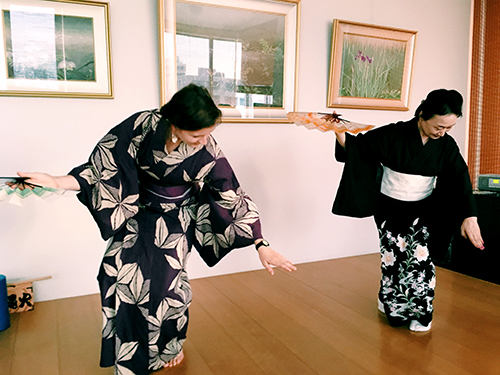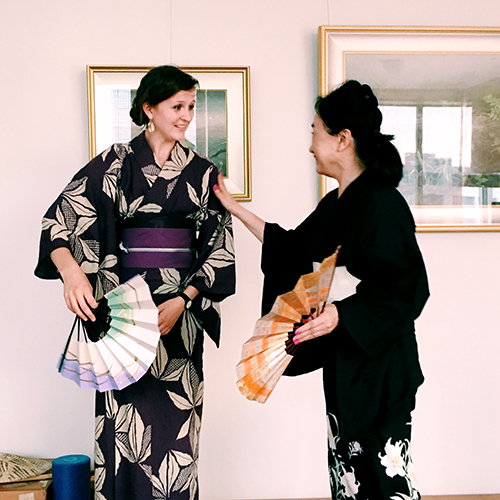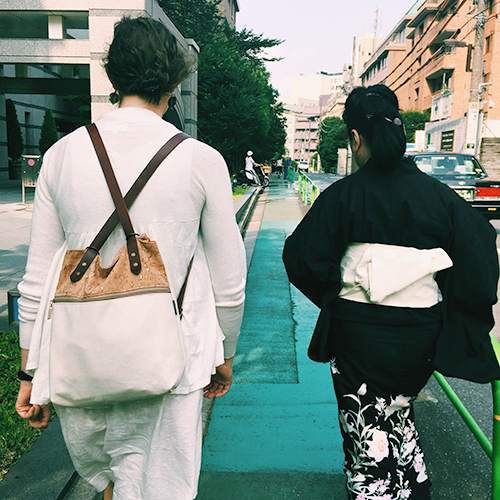So Many Moves
BY KATHARINE HAWTHORNE; PHOTOS BY BEN HERSH
Tomoko Suzuki is at the peak of her dancing career. She performs as a featured soloist at the National Kabuki Theater in Tokyo. She is in her 60s. Tomoko tells me this is not uncommon. In Kabuki, performers peak between age 50-60. Her movements are efficient and succinct, powerful and clear.
Last July while traveling in Japan, I had a chance to meet Tomoko and have a conversation about dance. She showed me videos of her past performances, including highlights of her dancing career ranging from roles requiring serious stamina and dramatic fortitude, to comedic favorites. I was impressed by the breadth of her repertoire as well as the precision of her execution. Every motion was well-considered and, at the same time, nothing felt artificial. Her dancing showed me what it meant to be human.
As part of our exchange, I showed her film of some of my recent performances in San Francisco with Liss Fain Dance and as a solo artist. She commented on the contemporary music and costumes and was astonished by the physicality of the movement, exclaiming, “So many moves!” In comparison with the austerity of Japanese classical dance, Western contemporary dance appears hyper-active, emphasizing athletic physical feats and near constant motion. Seen through Tomoko’s eyes, I realized the degree to which my dancing is kinetically driven, perhaps at the expense of a sense of simplicity and human resonance.
Tomoko gave me a lesson in her private dance studio in her home. She dressed me in a kimono and handed me two fans. She danced and I followed her movements, allowing myself to drop into her tempo and quality. I felt the specificity of her movements, how each shift of weight and inclination of her head communicated her intent. We repeated the same dance many times, finding more nuance and playfulness each go.
My time with Tomoko, although brief, was immensely impactful in its simplicity. We age and we keep dancing. And we get better. We learn how to more clearly express what we mean and who we are. The best dancing is the most human. The best way to become more human is to live more.
It might be tempting to draw a comparison between East and West, between the classical form of Kabuki and contemporary dance. However, for me, this experience was not about how different cultures view artistic expression or aging. Rather, it was a way to better understand what matters in dance and what makes us human.
Since my encounter with Tomoko, I have reflected on that day many times, and the phrase “so many moves!” continues to stay with me. Despite my best efforts, I often feel that my dance career is on a timeline. Even with an expansive sense of the possibilities of my performance career, I rarely forecast forward to how I will be dancing when I am 60. In my anxiety, I may have tried to do too much too soon, to cram too many movements into too short of a timeframe. One of the corrections I often received as a younger dancer was to “complete each movement.” I always thought of this in terms of space, or kinetic trajectory, instead of considering the temporal duration of a movement. Perhaps my teachers meant to say to me, “Allow each step to complete in its own time.” Instead of “so many moves,” how about “so much time”?
~~
Katharine Hawthorne is a San Francisco based dancer and choreographer. She is presently creating a new dance called Between the Wish and the Thing that asks the audience to imagine the future. To learn more, visit www.khawthorne.net.
Postscript: Tomoko Suzuki responded to Katharine’s essay with the following…
I am impressed by your comments. Japanese classic dancing is to tell the story, and in fact I think Western modern dancing is the same. The difference would be probably that the former is representational while the latter is rather abstract though both are emotional, spiritual and human. I hope you keep dancing, and cheer up the audience.
Also, Kabuki is a musical where only men can perform. Only actors, no actress. The dancing part became a classic dancing, which I have engaged in.



